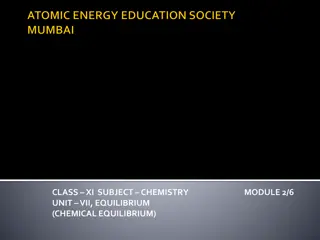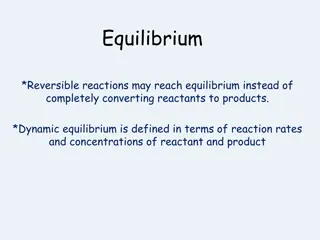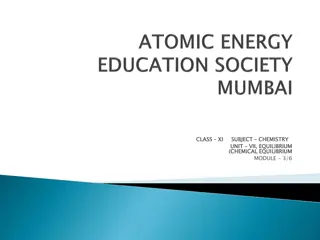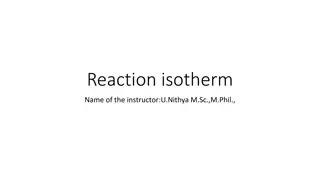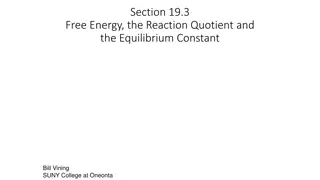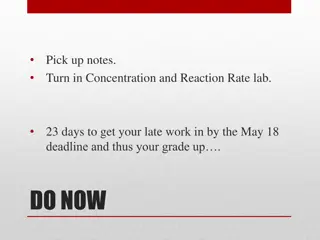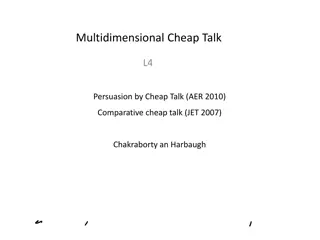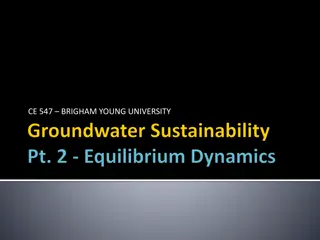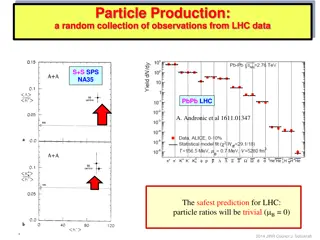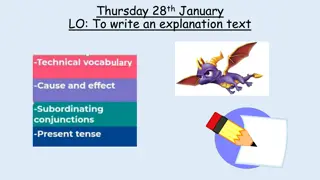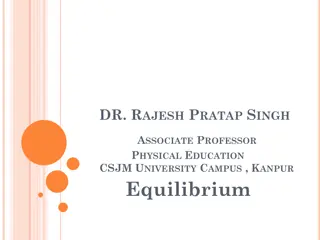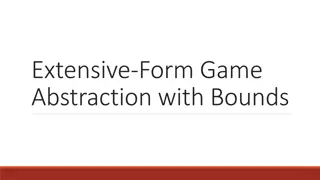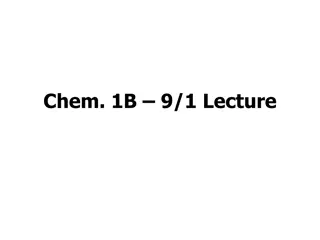
Solving Problems with Moments in Physics
Learn about moments and tilting in physics through practical exercises involving planks, rods, and equilibrium scenarios. Understand how forces and weights affect balance and tipping points. Explore the concepts of reactions, equilibrium, and modeling systems as particles to solve moment-related problems effectively.
Download Presentation

Please find below an Image/Link to download the presentation.
The content on the website is provided AS IS for your information and personal use only. It may not be sold, licensed, or shared on other websites without obtaining consent from the author. If you encounter any issues during the download, it is possible that the publisher has removed the file from their server.
You are allowed to download the files provided on this website for personal or commercial use, subject to the condition that they are used lawfully. All files are the property of their respective owners.
The content on the website is provided AS IS for your information and personal use only. It may not be sold, licensed, or shared on other websites without obtaining consent from the author.
E N D
Presentation Transcript
Moments Tilting
Moments KUS objectives BAT understand moment and solve problems using moments when a rod is at a tipping point / about to Tilt around a picot Starter: A plank of wood is balanced on a fulcrum. The fulcrum is 0.7m from the end of the plank. A box weighing 10 kg has been placed on the left of the fulcrum, as shown. A force of 5N is applied to the other end of the plank. How far from the fulcrum does a force need to be applied for the system to be balanced? 5N Taking moments about fulcrum (pivot) 10? 0.4 = 5 ? ? =10? 0.4 a LONG way from the fulcrum = 7.84 m 5
WB31a A plank of wood AB has mass 10 kg and length 4 m. It rests in a horizontal position on two smooth supports. One support is at the end A. The other is at the point C, 0.4 m from B, as shown. A weight of mass 30 kg stands at B with the plank in equilibrium. By modelling the plank as a uniform rod and the girl as a particle, a) Find the reaction on the plank at A Find the reaction on the plank at A if the weight is increased to b) 35 kg or c) 40 kg d) Explain what you expect to happen to the reaction at A if the weight at B is steadily increased
?? ?? WB31b ? ? ??? ??? a) Resolving the Forces: ??+ ??= 40 ? ??= 10.89 ? M(C) 3.6 ??+ 0.4 ??? = 1.6 10? ??= 5.44 ? b) M (C) 3.6 ??+ 0.4 ??? = 1.6 10? c) M (C) 3.6 ??+ 0.4 ??? = 1.6 10? ??= 0 ? d) As the weight at B is steadily increased the plank will reach a tipping point after which the weight will be too great for the plank to remain in equilibrium The reaction at A decreases until it reaches zero at the tipping point
WB32a A plank of wood AB has mass 10 kg and length 4 m. It rests in a horizontal position on two smooth supports. One support is at the end A. The other is at the point C, 0.4 m from B, as shown. A boulder of mass m kg is placed on the plank at A and a man of mass 80 kg stands on the plank at B a) find the reaction on the plank at A. The plank remains in equilibrium and is on the point of tilting about C. b) By modelling the plank again as a uniform rod, and the man and the boulder as particles, find the value of m
WB32b ?? ??= ? ? ? 8?? ?? ??? Resolving the Forces: ??+ ??= (90 + ?) ? M(C) 0.4 80? = 1.6 10? +3.6 ?? 313.6 = 156.8 +35.28? ? =40 9= 4.44 ??
WB33a A plank AB has length 4 m. It lies on a horizontal platform, with the end A lying on the platform and the end B projecting over the edge, as shown below. The edge of the platform is at the point C. Jack and Jill are experimenting with the plank. Jack has mass 40 kg and Jill has mass 25 kg. They discover that, if Jack stands at B and Jill stands at A and BC = 1.6 m, the plank is in equilibrium and on the point of tilting about C. By modelling the plank as a uniform rod, and Jack and Jill as particles, (a) Find the mass of the plank. ?? Jack Jill A C B 2m 1.6m ??? ?? ??? M(C) 25? 2.4 + ?? 0.4 = 40? 1.6 60? + 0.4?? = 64? ? = 10 kg
WB33bc They now alter the position of the plank in relation to the platform so that, when Jill stands at B and Jack stands at A, the plank is again in equilibrium and on the point of tilting about C. (b) Find the distance BC in this position. b) ?? ? Jack Jill ?? 10? ? 2 + 25? ? = 40? 4 ? ? ? ? 10?? 20? + 25?? = 160? 40?? 75?? = 180? ??? ??? x ??? ? =180? = 2.4 m 75? (c) State how you have used the modelling assumptions that (i) the plank is uniform, Weight acts at centre of plank Plankremains straight (ii) the plank is a rod, (iii) Jack and Jill are particles. Weights act at the ends of the plank
WB35ab A plank AE, of length 6 m and mass 10 kg, rests in a horizontal position on supports at B and D, where AB = 1 m and DE = 2 m. A child of mass 20 kg stands at C, the mid-point of BD, as shown in the diagram. The child is modelled as a particle and the plank as a uniform rod. The child and the plank are in equilibrium. Calculate: (a) the magnitude of the force exerted by the support on the plank at B, (b) the magnitude of the force exerted by the support on the plank at D. B D E A C 2 m 1 m 2 m 1 m ?? ? ??=40 3? = 130.7 N 3 ??= 20? 1.5 + 10? 1 ?? ? ??=50 3? = 163.3 N 3 ??= 20? 1.5 + 10? 2 You could resolve forces to find ??instead ??+40 ??=50 ? 3? = 20? + 10? 3? N
WB35c A plank AE, of length 6 m and mass 10 kg, rests in a horizontal position on supports at B and D, where AB = 1 m and DE = 2 m. The child (of mass 20g) now stands at a point F on the plank. The plank is in equilibrium and on the point of tilting about D. (c) Calculate the distance DF. ?? x ? B D E A ??= 0 C 1 ? 1 m 2 m 6 m ??? ??? M(D) 20? ? = 10? 1 ? =1 2 m
WB36a A non-uniform plank XY of length 10 m and mass 40 kg rests on a horizontal table with the end Y projecting 4 m over the edge of the table as shown. When a package of mass 25 kg is placed on the plank 1 m from X and a package of mass 90 kg is placed on the plank 1.5 m from Y is in limiting equilibrium a) Find the distance of the centre of mass of the plank from X b) Find the magnitude of the force which the edge of the table exerts on the plank, giving your answer in terms of g The 25 kg package is removed, and the 90 kg package is moved so that the plank is again in limiting equilibrium c) Find how far the package is from Y ??? ? ? ? ?
? WB36b ? ? ? ? ? ?.? ? ??? ??? ??? b) R( ) ? = 25? + 40? + 90? = 155? a) M(X) 25? 1 + 40? ? + 90? 8.5 = 155? 6 ? =155 6 25 90 8.5 = ?.? ? 90 ? ? ? ? c) R( ) ? = 40? + 90? = 130? ?.? ? ??? ??? M(Y) 40? 6.5 + 90? ? = 130? 4 ? =130 4 40 6.5 =26 9= ?.?? ? 90
KUS objectives BAT understand moment and solve problems using moments on a Non- Uniform rod and/or when a rod is at a tipping point self-assess One thing learned is One thing to improve is


